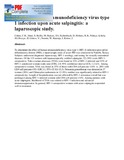Effect of human immunodeficiency virus type 1 infection upon acute salpingitis: a laparoscopic study.

View/
Date
1998Author
Cohen, C.R,
Sinei, S
Reilly, M
Bukusi, EA
Eschenbach, D
Holmes, K.K
Ndinya-Achola, JO
Bwayo, JJ
Grieco, V,
Stamm, W
Karanja, J
Kreiss, J.
Type
ArticleLanguage
enMetadata
Show full item recordAbstract
To determine the effect of human immunodeficiency virus type 1 (HIV-1) infection upon pelvic inflammatory disease (PID), a laparoscopic study of acute PID was conducted in Nairobi, Kenya. Subjects underwent diagnostic laparoscopy, HIV-1 serology, and testing for sexually transmitted diseases. Of the 133 women with laparoscopically verified salpingitis, 52 (39%) were HIV-1-seropositive. Tubo-ovarian abscesses (TOA) were found in 33% of HIV-1-infected and 15% of HIV-1-uninfected women (odds ratio [OR], 2.8; 95% confidence interval [CI], 1.2-6.5). Among seropositive women, TOA was found in 55% of those with CD4 cell percent <14% vs. 28% with CD4 cell percent>14% (OR 3.1, 95% CI 0.6-15.3). Neisseria gonorrhoeae was detected in 37 women (28%) and Chlamydia trachomatis in 12 (9%); neither was significantly related to HIV-1 seropositivity. Length of hospitalization was not affected by HIV-1 serostatus overall but was prolonged among HIV-1-infected women with CD4 cell percent <14%. Among patients with acute salpingitis, likelihood of TOA was related to HIV-1 infection and advanced immunosuppression. In general, HIV-1-seropositive women with acute salpingitis responded well to treatment.
URI
http://www.ncbi.nlm.nih.gov/pubmed/9780255http://erepository.uonbi.ac.ke:8080/xmlui/handle/123456789/17108
Citation
J Infect Dis. 1998 Nov;178(5):1352-8Collections
- Faculty of Health Sciences (FHS) [10378]
